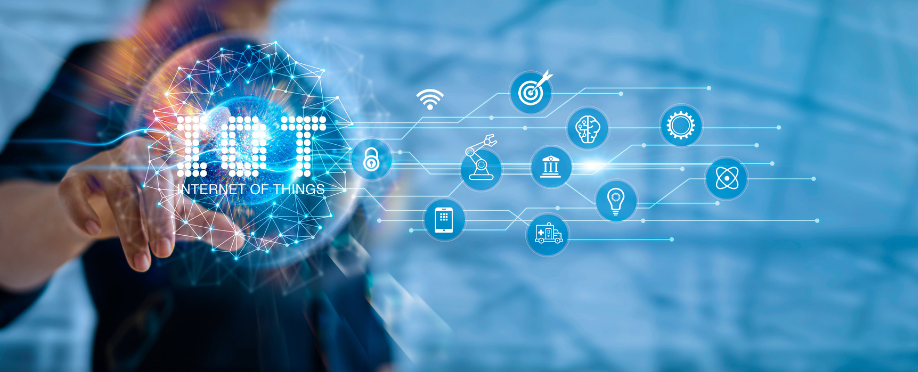
Perhaps the hottest trend in facilities management, “smart” building technologies aren’t just on the rise — with the number of smart buildings expected to increase from 45 to 115 million over the course of 2022 to 2026, it’s clear smart building technology is being adopted at an accelerating rate.
But where does the grocery industry stand in all of this? We spoke with Tom Mathews, SVP of Sustainability and Energy Services at City Building & Engineering Services (CBES). A food retailing industry engineering professional who’s been working in the supermarket industry for nearly four decades, he provided us with an update of where the industry is at with smart building technology and what we can expect in the coming years.
What is meant by smart buildings?
Smart buildings, also known as intelligent buildings, are facilities that use technology to connect building systems such as HVAC, refrigeration, and lighting into a single network. Using sensors, software, and both wired and wireless connectivity, the energy-using systems in smart buildings collect data, communicate digitally with each other, and interact in ways that minimize total building energy usage and GHG emissions while optimizing the operation of each of these systems.
With their ability to keep track of their own energy-using systems’ operating data, sometimes even including maintenance history, smart buildings allow facility management teams to make more informed decisions about:
- Where building repairs and maintenance are required
- Where equipment replacements are needed
- Where further system upgrades and automation can improve the performance of their buildings
These data-informed insights lead to more efficient equipment maintenance and energy consumption management practices and processes, as well as buildings better able to meet company and societal GHG emission reduction goals.
“Until recently, we’ve been talking mostly one-way communication from energy-using equipment in most grocery stores. That’s all changing,” Tom says. In a fully operational IoT smart building setup, energy-using equipment and systems would be able to communicate with each other as well as remote cloud-based advanced optimization applications, with this shared knowledge allowing every major building system element to operate in a way that advances all building operating goals.
Benefits of smart buildings for grocery stores
The advantages of smart buildings in the grocery store industry are far-reaching. Facilities management leaders can look forward to the following benefits of upgrading to smart systems:
- Minimized energy consumption, energy demand, and energy expense
- Substantial and sustainable reductions in GHG emissions
- Higher-quality perishable products
- Better customer shopping experience
- Targeted repair and maintenance services and spend
- Targeted CAPEX spend
- Extended equipment service lifetimes
- Lower maintenance costs
- More straight time repairs
Additionally, with straight time repairs, not only are repair costs lowered, so are the number of on-call hours worked by service techs, often in the middle of the night, or on weekends, improving their work-life balance and keeping them in the critical building trades where they are so badly needed.
Sound too good to be true? It’s not. We all have examples around us of intelligent systems or devices that are providing these benefits, such as the cars we’re driving, the new appliances we’re buying, and the cellphones we’re carrying. Many of these devices continue to get smarter every day through software updates and improvements. That’s one of the biggest benefits smart buildings can bring — improvements that can and are made without replacing equipment. Over time, smart equipment can add functionality and features at very low cost thanks to software downloads and new in-device or cloud-based applications and capabilities.
With today’s market conditions, the food retailing refrigeration, HVAC, and other electrical and mechanical equipment and systems are ripe for a smart revolution. “The demand for smart building solutions is anticipated to rise due to the growing need for lower operating costs, lower CO2 emissions, and the scarcity of energy resources,” Future Market Insights reports. “North America is estimated to capture the largest share and lead the global smart buildings solution market, accounting for 38.3% of the overall market share in 2022.”
Smart building technologies in grocery stores
While supermarkets increasingly boast smart building technologies, Tom says a fully smart grocery store doesn’t exist yet in the U.S. “While some of the biggest companies in automation have entered the supermarket facilities space, no one has been very successful … yet. But with the potential ROI and other advantages of smart buildings, there’s lots of development work going on.”
Tom says facilities managers will see standardized equipment get prioritized first. “Just as with automobiles, when you have tens of thousands of standardized units being produced, it becomes practical to invest development time trying to enhance the technology,” he explains. Machines that use the most energy or provide the highest-value functions will also advance at a faster pace.
So, when can we expect to see smart building technologies come to fruition in U.S. grocery stores? “I feel within twenty years the pressure of sustainability demands and the scarcity of highly trained maintenance professionals in our industry will force the level of standardization that will be required to enable truly smart food retailing industry equipment, systems, and buildings,” Tom predicts.
Still, it’s critical for facilities managers to take action today in order to start tapping into smart technology. Tom says it’s all about “baby steps.” Here’s how to get started:
Tap into existing data sources
Right now, Tom says the big push is to capture all the available value from the data that’s currently coming from supermarket facilities equipment. “Facilities managers are trying to extract both more data and more capability from the legacy electronic control systems that started to appear in the early 1980s and were in most food retailing stores by 2000. Until now, that data and many existing capabilities have been largely underutilized in almost every one of these stores, with less than as little as 20 percent of total available building and refrigeration control capabilities utilized.”
Learning how to collect and use this data is fundamental to the smart building revolution. While smart devices themselves are designed to collect digital information, users need to have applications in place to capture the data for more informed decision-making. Programs and processes have to be tested.
Even without the whole building being smart, there’s a lot to be gained from a store’s existing smart devices. “When you can see the energy use and operating history of the energy-using equipment in typical food retail facilities, then you can start coordinating their operation and getting the benefits of a smart building infrastructure,” Tom explains.
Get smart about investing in smart equipment
While the age of smart supermarkets may be a little ways off, grocery stores have a lot to gain by adopting smart building technologies today — as long as they’re selective in their choices.
A cost-benefit analysis can help facility management teams determine which smart equipment to invest in first. “The machines where smart technologies will be adopted first are the ones that are the most standardized, use the most energy, and handle the most valuable functions,” Tom says.
Today’s HVAC rooftop units are an example of equipment that manufacturers have advanced to a sophisticated level of intelligence, with the ability to communicate everything going on within the unit to remote operators and systems and the ability to carry out self-diagnosing functions. Other getting-smarter technologies include meat wrapping systems and self-contained food service/prep area refrigerators and cooking equipment.
On the other hand, Tom explains, refrigeration systems aren’t adequately standardized. “There’s too much variation from manufacturer to manufacturer to be able to develop a truly smart large scale supermarket central plant or distributed refrigeration system just yet.” Of course, technologies are quickly changing every day, Tom adds. “With a lot of equipment, we’re just not there yet, but we will be.”
Partner with a tech-savvy provider
Partnering with a third-party engineering services provider well-versed in smart technologies and data analytics will be critical for building owners and operators in the coming years.
Tom says that at CBES, a major focus is helping retail clients get more value out of the control systems they currently have. Through their in-house remote services center, the CBES team continuously monitors key pressures and temperatures in critical facility refrigeration, HVAC, standby power, and other building systems. When monitoring engineers or monitoring software detects an operating issue, the remote services center first works to identify the issue cause, then resolve it (or “put a patch on it” until daytime, straight time business hours) remotely if possible, and where dispatch is required, send the servicing technician on their way with an accurate description of the problem and what actions, parts, and materials might be required to resolve it.
In addition, a “smart” engineering services provider can serve a critical role as an independent arbiter when vetting smart software applications, smart machines and devices, and smart building system architectures. “The right partner can help identify existing opportunities for purchasing and using smart equipment and determine whether it’s worth it or not financially,” Tom says.
Most importantly, we’re here to help guide [clients] on the path to smart building. They may not know it, but they’re already on one.Tom Mathews, SVP of Sustainability and Energy Services at CBES
“Most importantly, we’re here to help guide them on the path to smart building,” he adds. “They may not know it, but they’re already on one. We just tell them how they can advance on it and when they may be moving too slowly or too quickly.”
Innovative solutions leveraging technology enablement
While the path to fully smart buildings may be a long one, it’s critical to make progress in order to stay competitive and meet sustainability requirements and commitments. CBES offers an integrated engineering team that offers end-to-end system analysis of new and existing systems with the goal of minimizing energy usage, operating expenses, and environmental impact.


 2016: City US is established in North America, in partnership with Southeastern Grocers (SEG), servicing over 750 supermarkets across 7 southern states.
2016: City US is established in North America, in partnership with Southeastern Grocers (SEG), servicing over 750 supermarkets across 7 southern states. 1985: Willie and Susan Haughey establish City Refrigeration Holdings (UK) Ltd in Glasgow, UK.
1985: Willie and Susan Haughey establish City Refrigeration Holdings (UK) Ltd in Glasgow, UK. 2009: City Australia launches in Melbourne, in partnership with Coles, servicing over 700 supermarkets across the country.
2009: City Australia launches in Melbourne, in partnership with Coles, servicing over 700 supermarkets across the country. 2015: City Asia launches in Kuala Lumpur, Malaysia, in partnership with Dairy Farm, servicing over 205 supermarkets across the region.
2015: City Asia launches in Kuala Lumpur, Malaysia, in partnership with Dairy Farm, servicing over 205 supermarkets across the region.